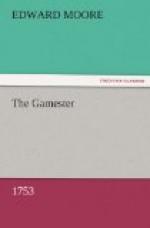Despite the popularity of their plays, neither Lillo nor Moore inspired any significant followers in England. On the Continent, however, their influence was considerable. In his introduction to his edition of The London Merchant, A.W. Ward traces Lillo’s influence on the Continent, and Caskey gives a detailed account of Moore’s (119-134). The Gamester was translated into German, French, Dutch, Spanish, and Italian. It was first acted at Breslau in 1754 and retained its stage popularity for more than two decades. A German translation appeared in 1754, and for more than twenty years numerous editions and translations continued to appear. In France, Diderot admired the play and translated it in 1760 (not published until 1819); Saurin’s translation and adaptation (1767) proved popular on the French stage (he later provided an alternate happy ending which was frequently played).
The Gamester is reproduced, with permission, from a copy owned by the University of Michigan.
Charles H. Peake
University of Michigan
BIBLIOGRAPHICAL NOTE
The first edition of Moore’s The Gamester appeared in 1753 shortly after the opening of Garrick’s performance of the play on February 7. This edition is in many respects a good text; it has seemed desirable for several reasons, however, to reprint this work from the 1756 edition of Poems, Fables, and Plays (often referred to as the “Collected Works"). The 1756 text often corrects that of 1753 and is generally superior to later printings; it contains passages and improved readings not present in other editions; it aims at formal correctness, employing classical scene division; as a “Works” edition it exhibits excellent editorial and typographical treatment; it enjoys a superior general readability advantageous to classroom use; and, finally, it contains Moore’s vindicatory preface, which, as far as an examination of available copies shows, does not appear in other editions. Inasmuch as the 1756 printing is somewhat late, standing between the fourth and fifth editions of the play, a brief bibliographical account of The Gamester is offered.




